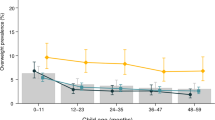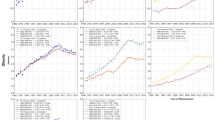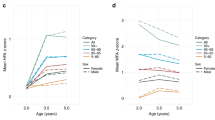Abstract
Objective:
To present body mass index (BMI) percentiles representative for children in Germany and to compare them with the currently used percentiles by Kromeyer–Hauschild (KH) and international percentiles of the World Health Organisation (WHO) and the International Obesity Task Force (IOTF).
Methods:
Representative examination survey of 17 641 children and adolescents aged 0–17 years living in Germany (KiGGS 2003–2006 study, response rate 67%) with standardized measurement of height and weight.
Results:
Generally, BMI in KiGGS was higher than in the reference populations from previous decades. KiGGS shows an asymmetric upward shift of the BMI distribution from about age 6 years and an earlier adiposity rebound compared with KH. The BMI peak in the first year of life is shown by KiGGS and WHO, but much less by KH. The cut-offs for overweight and obesity determined with the IOTF methodology in KiGGS (percentiles corresponding to BMI 25 and 30 kg/m2 at 18 years of age) were similar to IOTF cut-offs from age 18 to 10 years but systematically lower for younger children.
Conclusions:
The KiGGS BMI percentiles appear more valid for Germany than present alternatives and should be used for population monitoring. Despite their methodological limitations, the general shape of the older German KH references is confirmed by KiGGS for the ages 2–17 years. In order not to obscure the increase in obesity rates in the last decades, we therefore propose to continue using KH for individual diagnosis and estimation of the prevalence of overweight and obesity in this age range.
This is a preview of subscription content, access via your institution
Access options
Subscribe to this journal
Receive 12 print issues and online access
$259.00 per year
only $21.58 per issue
Buy this article
- Purchase on Springer Link
- Instant access to full article PDF
Prices may be subject to local taxes which are calculated during checkout



Similar content being viewed by others
References
Apfelbacher CJ, Cairns J, Bruckner T, Mohrenschlager M, Behrendt H, Ring J et al. (2008). Prevalence of overweight and obesity in East and West German children in the decade after reunification: population-based series of cross-sectional studies. J Epidemiol Community Health 62, 125–130.
Bellizzi MC, Dietz WH (1990). Workshop on childhood obesity: summary of the discussion. Am J Clin Nutr 70, 173S–175S.
Cacciari E, Milani S, Balsamo A, Dammacco F, De Luca F, Chiarelli F et al. (2002). Italian cross-sectional growth charts for height, weight and BMI (6–20 y). Eur J Clin Nutr 56, 171–180.
Cole TJ, Bellizzi MC, Flegal KM, Dietz WH (2000). Establishing a standard definition for child overweight and obesity worldwide: international survey. BMJ 320, 1240–1246.
Cole TJ, Freemann J, Preece M (1995). Body mass index reference curves for the UK, 1990. Arch Dis Child 73, 25–29.
Cole TJ, Green P (1992). Smoothing reference centile curves: the LMS method and penalized likelihood. Stat Med 11, 1305–1319.
de Onis M, Onyango AW, Borghi E, Siyam A, Nishida C, Siekmann J (2007). Development of a WHO growth reference for school-aged children and adolescents. Bull World Health Organ 85, 660–667.
Del-Rio-Navarro BE, Velazquez-Monroy O, Santos-Preciado JI, Lara-Esqueda A, Berber A, Loredo-Abdala A et al. (2007). Mexican anthropometric percentiles for ages 10–18. Eur J Clin Nutr 61, 963–975.
Hall DM, Cole TJ (2006). What use is the BMI? Arch Dis Child 91, 283–286.
Herpertz-Dahlmann B, Geller F, Bohle C, Khalil C, Trost-Brinkhues G, Ziegler A et al. (2003). Secular trends in body mass index measurements in preschool children from the city of Aachen, Germany. Eur J Pediatr 162, 104–109.
Himes JH, Dietz WH (1994). Guidelines for overweight in adolescent preventive services: recommendations from an expert committee. The expert committee on clinical guidelines for overweight in adolescent preventive services. Am J Clin Nutr 59, 307–316.
Kahl H, Schaffrath Rosario A, Schlaud M (2007). Sexual maturation of children and adolescents in Germany. Results of the German health interview and examination survey for children and adolescents (KiGGS). Bundesgesundheitsblatt Gesundheitsforschung Gesundheitsschutz 50, 677–685.
Kalies H, Lenz J, von Kries R (2002). Prevalence of overweight and obesity and trends in body mass index in German pre-school children, 1982–1997. Int J Obes Relat Metab Disord 26, 1211–1217.
Kromeyer-Hauschild K, Wabitsch M, Kunze D, Geller F, Geiß H, Hesse V et al. (2001). Perzentile für den Body-Mass-Index für das Kindes- und Jugendalter unter Heranziehung verschiedener deutscher Stichproben. Monatsschrift Kinderheilkunde 149, 807–818.
Kromeyer-Hauschild K, Zellner K (2007). Trends in overweight and obesity and changes in the distribution of body mass index in schoolchildren of Jena, East Germany. Eur J Clin Nutr 61, 404–411.
Kurth BM, Kamtsiuris P, Holling H, Schlaud M, Dolle R, Ellert U et al. (2008). The challenge of comprehensively mapping children's health in a nation-wide health survey: design of the German KiGGS-study. BMC Public Health 8, 196.
Kurth BM, Schaffrath Rosario A (2007). The prevalence of overweight and obese children and adolescents living in Germany. Results of the German health interview and examination survey for children and adolescents (KiGGS). Bundesgesundheitsblatt Gesundheitsforschung Gesundheitsschutz 50, 736–743.
Lindgren G, Strandell A, Cole T, Healy M, Tanner J (1995). Swedish population reference standards for height, weight and body mass index attained at 6 to 16 years (girls) or 19 years (boys). Acta Paediatr 84, 1019–1028.
Luciano A, Bressan F, Zoppi G (1997). Body mass index reference curves for children aged 3–19 years from Verona, Italy. Eur J Clin Nutr 51, 6–10.
Meigen C, Keller A, Gausche R, Kromeyer-Hauschild K, Bluher S, Kiess W et al. (2008). Secular trends in body mass index in German children and adolescents: a cross-sectional data analysis via CrescNet between 1999 and 2006. Metabolism 57, 934–939.
Moreno LA, Mesana MI, Gonzalez-Gross M, Gil CM, Fleta J, Warnberg J et al. (2006). Anthropometric body fat composition reference values in Spanish adolescents. The AVENA study. Eur J Clin Nutr 60, 191–196.
Moss A, Wabitsch M, Kromeyer-Hauschild K, Reinehr T, Kurth BM (2007). Prevalence of overweight and adiposity in German school children. Bundesgesundheitsblatt Gesundheitsforschung Gesundheitsschutz 50, 1424–1431.
Must A, Dallal GE, Dietz WH (1991a). Reference data for obesity: 85th and 95th percentiles of body mass index (wt/ht2) and triceps skinfold thickness. Am J Clin Nutr 53, 839–846.
Must A, Dallal GE, Dietz WH (1991b). Reference data for obesity: 85th and 95th percentiles of body mass index (wt/ht2)- a correction. Am J Clin Nutr 54, 773.
Pan H, Cole TJ (2004). A comparison of goodness of fit tests for age-related reference ranges. Stat Med 23, 1749–1765.
Rolland-Cachera MF, Cole TJ, Sempe M, Tichet J, Rossignol C, Charraud A (1991). Body mass index variations: centiles from birth to 87 years. Eur J Clin Nutr 45, 13–21.
Royston P, Wright EM (2000). Goodness-of-fit statistics for age-specific reference intervals. Stat Med 19, 2943–2962.
Silverwood RJ, De Stavola BL, Cole TJ, Leon DA (2009). BMI peak in infancy as a predictor for later BMI in the Uppsala family study. Int J Obes (Lond) 33, 929–937.
Stamatakis E, Wardle J, Cole TJ (2009). Childhood obesity and overweight prevalence trends in England: evidence for growing socioeconomic disparities. Int J Obes (Lond) 34, 41–47.
van Buuren S, Fredriks M (2001). Worm plot: a simple diagnostic device for modelling growth reference curves. Stat Med 20, 1259–1277.
von Kries R (2004). Adipositas bei Kindern in Bayern—Erfahrungen aus den Schuleingangsuntersuchungen. Gesundheitswesen 66 Sonderheft 1, 80–85.
WHO Multicenter Growth Reference Study Group (2006a). WHO child growth standards based on length/height, weight and age. Acta Paediatr Suppl 450, 76–85.
WHO Multicenter Growth Reference Study Group (2006b). Enrolment and baseline characteristics in the WHO multicentre growth reference study. Acta Paediatr Suppl 450, 7–15.
Wright CM, Booth IW, Buckler JM, Cameron N, Cole TJ, Healy MJ et al. (2002). Growth reference charts for use in the United Kingdom. Arch Dis Child 86, 11–14.
Zellner K, Jaeger U, Kromeyer-Hauschild K (2004). Height, weight and BMI of schoolchildren in Jena, Germany—are the secular changes levelling off? Econ Hum Biol 2, 281–294.
Acknowledgements
The German Health Interview and Examination Survey for Children and Adolescents (KiGGS) was funded by the German Ministry of Health, the Ministry of Education and Research and the Robert Koch Institute. We gratefully acknowledge valuable advice on the definition of the reference population given by Prof Dr MJ Müller, Kiel, Prof Dr V Hesse, Berlin, Dr U Langen, Berlin and M Thamm, Berlin.
Author information
Authors and Affiliations
Corresponding author
Rights and permissions
About this article
Cite this article
Schaffrath Rosario, A., Kurth, BM., Stolzenberg, H. et al. Body mass index percentiles for children and adolescents in Germany based on a nationally representative sample (KiGGS 2003–2006). Eur J Clin Nutr 64, 341–349 (2010). https://doi.org/10.1038/ejcn.2010.8
Received:
Revised:
Accepted:
Published:
Issue Date:
DOI: https://doi.org/10.1038/ejcn.2010.8
Keywords
This article is cited by
-
Clinical characteristics and outcomes of children, adolescents and young adults with overweight or obesity and mental health disorders
International Journal of Obesity (2024)
-
Lifespan changes in postural control
Scientific Reports (2023)
-
Metabolic control during the first two years of the COVID-19 pandemic in pediatric patients with type 1 diabetes: results from the German DPV initiative
Acta Diabetologica (2023)
-
Associations of attention-deficit/hyperactivity disorder with inflammatory diseases. Results from the nationwide German Health Interview and Examination Survey for Children and Adolescents (KiGGS)
neuropsychiatrie (2023)
-
Emulation of the control cohort of a randomized controlled trial in pediatric kidney transplantation with Real-World Data from the CERTAIN Registry
Pediatric Nephrology (2023)



